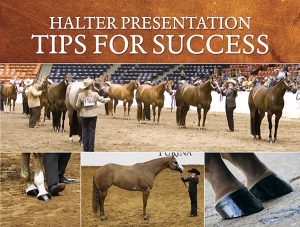
Halter Presentation – Tips For Success
Click here to read the complete article
 By Barbara Aitken Jenkins
By Barbara Aitken Jenkins
Presenting your horse in Halter comes with its own set of rules. Some you can find in the rulebook. Others are more “unwritten.” Professionals and judges Don Griffey, Jeffrey Pait, Jarrell Jackson, and Ross Roark share their secrets to success.
Halter classes are comprised of two sections—the walk and trot in, and the set-up and presentation to the judge. Halter is a straightforward class that’s classic in its makeup and enriched in tradition. To get a good grasp of the discipline, exhibitors are encouraged to read the rulebook. However, there are unwritten rules that can elevate your experience in the pen and ultimately affect your final placing.
First and foremost, “As a showman, you need to know a horse’s strengths and weaknesses and learn ways to highlight those strengths and hide the weaknesses of the horse,” Pait says. “A horse’s conformation is a horse’s conformation. We can enhance it a little bit, but your horse is what you have when you leave the house. You know pretty much what you have when you walk in the pen.”
It’s crucial that a competitor understands both the desired conformation for the breed and knows how his/her horse compares to the breed standard.
“Showing Halter really does start with having in-depth knowledge about your horse’s conformation,” Pait says. “It’s also important to know how your horse looks to other people. Getting feedback from other people is a great place to start. Watching videos or taking photos of your horse is also a great way to learn how your horse moves and stands.”
The Real Work Happens at Home
Recently Added
- The Mota Family Loses Home from the Minnesota Equestrian Center Fire November 22, 2024
- Brooke DeBuhr · Eyes On The Future November 22, 2024
- EC Photo of the Day – Allie Davis and Grace Under Fire November 22, 2024
- Straight Up Dirty Begins His Journey as Full Time Sire November 22, 2024
- All-Breed Horse Show Features 800 Entries from Multiple States November 21, 2024
- EC Photo of the Day – Never Negative Nick November 21, 2024
- Join the NCHA for the First Annual Celebrity Cutting November 21, 2024
- A Barn That’s More Like A Family: Jenell Pogue Performance Horses November 20, 2024
- EC Photo of the Day – Brylynn Balon and Made With Real Cocoa November 20, 2024
- More Around the Rings Photos – 2024 AQHA World Show November 20, 2024
Archives
Sign In
Equine Chronicle ® All Rights Reserved. Copyright © 2024
4727 NW 80th Ave. • Ocala, FL 34482 • 352 369 1104 • FAX 352 369 1521
Privacy Policy | Questions, please contact The Equine Chronicle
-









